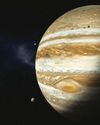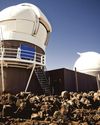CATEGORIES
Categories

15 STUNNING STAR CLUSTERS
These beautiful stellar groupings are spattered across the cosmos

Eileen Collins "It was a difficult mission...we were the first to see Mir"
Having served as both the first female pilot and first female commander of NASA's Space Shuttle, Collins boosted the involvement of women in space exploration to a whole new level

MYSTERIES OF THE UNI WHERE ARE ALL THE SPIRAL GALAXIES?
There are far fewer spiral galaxies than elliptical ones in the Supergalactic Plane, and scientists are keen to discover why

A sprinkling of cosmic dust may have helped kick-start life on Earth
Cosmic dust may have helped kick-start life on Earth. New findings challenge a widely held assumption that this wasn't a plausible explanation.

THE PILLS TO END AGEING
No longer the stuff of science fiction, affordable treatments that could slow, stop or even reverse your ageing are, thanks to new breakthroughs, less than a decade away... You might even be taking some of them already

CHANGE THE (BODY) CLOCKS
Why the end of British Summer Time can be a wake-up call for our circadian health

Scientists want to build a giant 'bio-vault' on the Moon.Here's why...
Experts say the best place to preserve cells from Earth's most important species is not on this planet

LIVING FOSSILS
FOR SOME CREATURES ALIVE TODAY TIME HAS ALMOST STOOD STILL. MEET THE 'LIVING FOSSILS' THAT GIVE US A GLIMPSE INTO LIFE IN THE DISTANT PAST

ECLIPSES ON DEMAND
Inside an unassuming building, behind a damp car park in Antwerp, Belgium, scientists are teaching two spacecraft to be dance partners for a performance that will take place in front of the Sun.

THE MEXICAN MOLE LIZARD
Imagine what would happen if an earthworm, a lizard, a snake and a mole went on a night out, had too much too much tequila and let their guard down.

ARE OCTOPUSES SENTIENT?
If you've watched the Netflix documentary My Octopus Teacher or been lucky enough to encounter an octopus in the wild, you'll know there's something special about them.

THE UNEXPECTED RETURN OF PNEUMATIC TUBES
Once a pioneering technology that revolutionised deliveries, pneumatic tubes had all but disappeared. Now they're back and enjoying a resurgence

Do We Finally Know How the Egyptian Pyramids Were Built? - A number of breakthrough studies are beginning to paint a picture of how these wonders of the world were built, but much of the story still remains a mystery...
A number of breakthrough studies are beginning to paint a picture of how these wonders of the world were built, but much of the story still remains a mystery...How the Egyptian pyramids were built has long been a mystery. Constructed as tombs for the pharaohs over 4,000 years ago, more than 100 of them remain. The largest one, the Great Pyramid of Giza, was originally 147m tall (482ft). It's made up of about 2.3 million stone blocks, each weighing between 2.5 and 15 tonnes, and would have had to be transported to the building site and lifted into place with techniques available at the time. To put this into context, it's akin to lifting a double-decker London bus to the top of St Pauls Cathedral a few million times.

How Light's 'Secret Code' Reveals the Story of the Cosmos- The starlight we can see tells us a lot about the Universe, but it's the parts we can't see that contain the biggest revelations
When you see photos from a modern telescope of a planet, nebula or distant galaxy, it's easy to be dazzled by the detail. But what astronomers get really excited about is a property of the light our eyes can't see: the spectrum. This secret code embedded in starlight can tell us not only what a celestial object is made of, but also the story of our cosmic past.Back in the 18th century, scientists discovered that each substance produced its own pattern of colours when it was burning. It turns out that each element, when heated, emits light at certain colours specific to that substance.

An Artificial Heart Inspired by Plumbing - Mechanical circulation could revolutionise transplant design and reduce waiting lists
Mechanical circulation could revolutionise transplant design and reduce waiting lists. In July, this artificial heart was successfully implanted, for the first time, into a patient with end-stage heart failure. Built by The Texas Heart Institute (THI) and BiVACOR, the replacement organ has been dubbed the Total Artificial Heart (TAH). Although, being an implant rather than transplant, it's designed to temporarily support patients while they wait for a real heart transplant.

Major Stonehenge Discovery Deepens Mystery Around Ancient Monument - New findings suggest a key six-tonne stone came from over 450 miles north of the circle
Cue the conspiracy theories: new research reveals that one of Stonehenge's central and larger megaliths came neither from England, nor Wales, but from the far northeast of Scotland - and we don't know how it got there. Experts think the six-tonne altar stone must have been dragged or floated at least 750km (466 miles) south to complete the prehistoric monument.

JUPITER KING OF PLANETS
Blast off with BBC Sky At Night's Ezzy Pearson as she takes you on a voyage to explore the largest planet in our solar system.

A visitor from outer space
Scientists have spent years looking for alien life, but what if it found us first?

Space toilets
Doing your business in space is not as easy as you might think.

What are wormholes?
Find out if space has secret passages that give shortcuts through the universe.

Is gaming good for you?
Gaming is great fun, but some worry it could be bad for young people's health.

TITANS
The biggest dinosaurs grew to truly epic proportions. Peter Gallivan tells the super-sized tale of these giant reptiles and discovers why they grew so large.

Gladys West
Meet the hidden figure behind the navigation system in your smartphone.

Ancient Egyptians may have used a hydraulic lift to build the first pyramid
Ancient Egyptians may have used an elaborate hydraulic system to construct the world's first pyramid. Known as the Pyramid of Djoser, the step pyramid was built around 4,700 years ago on the Saqqara plateau, an archaeological site in northern Egypt.

Webb confirms the earliest known galaxy is erupting in stars
The James Webb Space Telescope has spotted the earliest galaxy ever seen, and its unusually bright light is coming from a bizarre frenzy of star formation. Named JADES-GS-z14-0, the galaxy formed at least 290 million years after the Big Bang and contains stars that have been bursting into life since an estimated 200 million years after our universe began.

Sapphires form inside volcanoes, not deep in the mantle
Brilliant-blue sapphires look like bits of sky brought down to Earth, but a new study finds these gemstones are from a different boundary: the one between the planet's crust and magma welling up from the mantle, Earth's middle layer. Sapphires have been thought to form in the mantle itself or in the lower sections of the crust.

WHAT IS SUNBURN?
How solar rays can leave us red, sore and irritated

URBAN WILDLIFE
How wild animals have evolved to thrive alongside humans in towns and cities

BUILDING ONE WORLD TRADE CENTER
One World Trade Center rose from the ashes of the Twin Towers. Now, as the tallest building in New York City, it looks to the skies and the future. Here's how this sustainable and secure record-breaker was built

LIFTING THE LID ON ANTARCTICA
What was the coldest continent like without ice?